Bangladesh
Country statistics
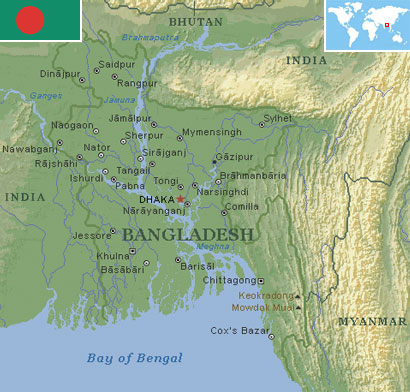
Land area: 51,703 sq miles (133,911 sq km)
Total area: 55,599 sq miles (144,000 sq km)
Population (2010 est.): 158,065,841 (growth rate: 1.2%); birth rate: 23.8/1000; infant mortality rate: 57.8/1000; life expectancy: 60.6; density per sq km: 1,146
Capital City: Dhaka
Monetary unit: Taka
Languages: Bangla (official), English
Ethnicity/race: Bengali 98%, tribal groups, non-Bengali Muslims (1998)
Religions: Islam 83%, Hindu 16%, other 1% (1998)
Country introduction
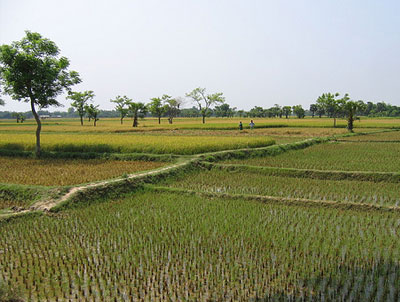
Bangladesh is a country in South Asia. It is bordered by India and Myanmar (Burma) and faces the Bay of Bengal to its south. Together with the Indian state of West Bengal, it makes up the region of Bengal. The name Bangladesh means "Country of Bengal" in the official Bengali language.
Hiding behind the evening-news images of cyclones and floods, is a lush land with a rich history. Tourists can visit archaeological sites dating back over 2000 years, walk on the longest beach, trek the largest littoral mangrove forests in the world, and see the decaying mansions of 19th century maharajas.
Bangladesh contains greater biodiversity than that of many countries taken together. Indeed few countries in the world can match its rich and varied flora and fauna which are not only a unique biological phenomenon but are also a great natural resources of the country.
The landscape is mainly flat with many bamboo, mango and palm-covered plains. A large part of Bangladesh is made up of alluvial plain, caused by the effects of the two great river systems of the Ganges (Padma) and the Brahmaputra (Jamuna) and their innumerable tributaries. In the north-east and east of the country the landscape rises to form forested hills. To the south-east, along the borders of Myanmar and India, the land is hilly and wooded.
Famine and disease visit the land, but it is flooding that makes Bangladesh one of the most disaster-prone places on Earth. Storm clouds and hurricanes travel up the Bay of Bengal, hit the Himalaya along the nation's northern border and stop, pouring water on the land, which is largely flat. When the rains come, villagers head for large concrete platforms scattered throughout the coastal areas to wait out the high waters. When the flooding recedes, villagers sometimes find that the local river has changed its course: It now flows around their bridge and through the center of town.
The culture
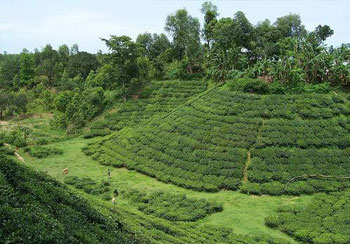
Bangladesh has a rich, diverse culture. Its deeply rooted heritage is thoroughly reflected in its architecture, dance, literature, music, painting and clothing. The three primary religions of Bangladesh (Hinduism, Buddhism and Islam) have had a great influence on its culture and history.
The people of Bangladesh have a rich fictional legacy, with the first available form of literature being over a thousand years old. Bengali literature developed considerably during the medieval period with the rise of popular poets such as Chandi Das, Daulat Kazi an Alaol.
The traditional music of Bangladesh is very much the same as that of the Indian sub-continent. The music in Bangladesh can be divided into three main categories: classical, modern and folk. Both vocal and instrumental classical music is enjoyed in Bangladesh. Ustad Ayet Ali Khan and Ustad Alauddin are two famous classical instrumental players that are internationally known. Modern music is becoming more popular and is practiced widely. Contemporary, pop songs and bands are also enjoying more widespread fame, but are mainly popular in the regions of Dhaka City.
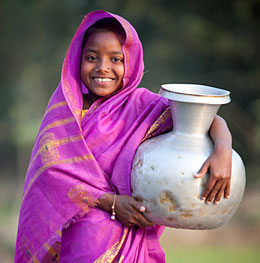
Tribal dances are very popular among the Bangalees. The countryside girls are in the habit of dancing to popular folk music. Their dances require no regulations as such, just a small amount of courage and a big amount of rhythm. Popular songs like Shari and Jari are presented with the accompanying dance of both male and female performers.
Drama and theatre is an old tradition that is very popular in Bangladesh. More than a dozen theater groups in Dhaka City have been regularly staging locally written plays for hundreds of years. Many have also started adopted some plays from European writers. Baily Road in Dhaka is known as "Natak Para" and this is one location where drama shows are regularly held. Many shows are also held at the Dhaka University.
Another important aspect of the culture of Bangladesh is clothing. Bangladeshi woman usually wear Saris, made of the world famous and expensive, finely embroidered quilted patchwork cloth produced by the village woman. Woman will traditionally wear their hair in a twisted bun, which is called the "Beni style". Hindus will traditionally wear Dhuty for religious purposes. These days most men of Bangladesh wear shirts and pants.
Attractions & landmarks
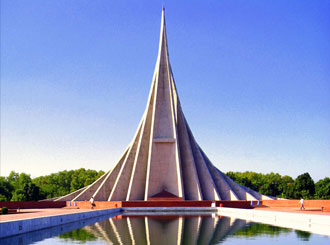
Tourist attractions are abound in Bangladesh. There are numerous places of interest in the capital city of Dhaka, which include viewing the many mosques and Hindu temples. Visitors can see the Dhakeshwari Temple, the Armenian Church, St. Mary's Cathedral at Ramna, the Holy Rosary Church at Teigaon, the Lalbagh Fort, the 1857 Memorial and the National Memorial (The Savar Monument). The Savar Monument is a Bangladeshi landmark, and was designed and created to honor those who lost their lives for the independence of Bangladesh. Visitors can also also purchase some of the beautiful handicrafts that are sold in the traditional markets of the city.
Whilst traveling through the second largest city, Chittagong, visitors will come across the lovely structures of Qadam Mubarak Mosque and Shahi Jama-e-Masjid. Of particular note, the Qadam Mubarak Mosque built in 1719, derives its name from a slab that bears an impression of Prophet Muhammad's foot. Other places of attraction include the intriguing Ethnological Museum, the Tomb of Sultan Bayazid Bostami, the World War II Cemetery, Shrine of Shah Amanat, Court Building Museum, Foy's Lake and Mercantile Marine Academy at Juldia. Also vast stretches of the Patenga and Fouzdarhat Sea Beaches can be walked and the pristine man made Kaptai Lake can be visited.
Cox Bazar is famous among tourists for being the longest unbroken beach slopes in the world. The soft golden sands of the beaches, the majestic cliffs, the verdant greenery, the colorful shrines and pagodas of Cox Bazar make it an idyllic holiday destination.
Sylhet is known for its exotic beauty, the flora and fauna, the tea plantations and the tropical forests. Places of attraction include Madhabkunda, Tamabil-Jaflong and the Shrine of Hazrat Shah Jalal.
Nature lovers will definitely want to stop at Bangladesh's natural attraction: Sundarbans National Park. This park boasts the world's largest mangrove belt and is one of the largest reserves for the Bengal tiger.